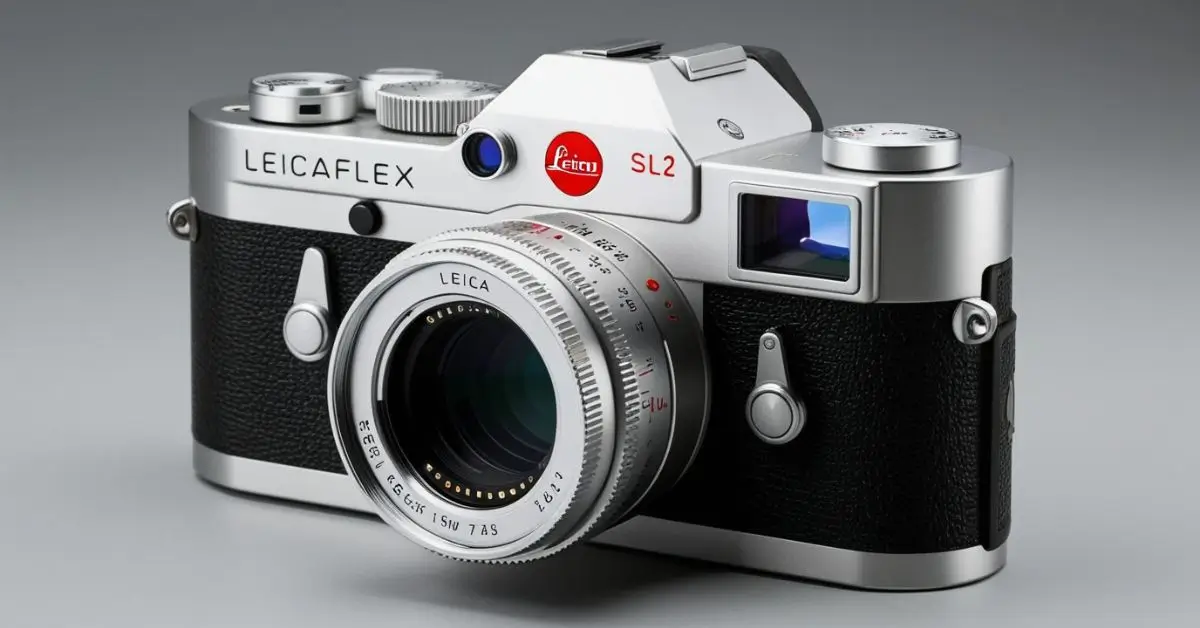The Leica Leicaflex SL2, introduced in 1974, is one of the most revered single-lens reflex (SLR) cameras produced by the iconic German camera manufacturer, Leica. Renowned for its superior build quality, precision mechanics, and optics, the SL2 marked the culmination of Leica’s early attempts to enter the SLR market. While Leica is best known for its rangefinder cameras, the Leicaflex series stands as a testament to the company’s commitment to excellence across different camera types. The Leicaflex SL2, the final model in the Leicaflex line, has earned legendary status among photographers and collectors alike, representing a blend of engineering craftsmanship and photographic utility.
Leica’s History in the SLR Market
Before diving into the specifics of the SL2, it’s essential to understand Leica’s transition into the SLR market. Leica, founded in 1914 by Ernst Leitz, made a name for itself with its precision-built rangefinder cameras. These cameras were popular among both professional and amateur photographers for their compact size, superb optics, and reliability. However, by the 1960s, the photographic world was shifting. SLR cameras were gaining popularity due to their ability to offer through-the-lens viewing, interchangeable lenses, and superior depth-of-field control.
Leica’s initial response to this market shift was the Leicaflex, released in 1964. While it was a mechanically sophisticated camera, it lacked some of the features that made competing models from brands like Nikon and Canon more appealing, such as automatic exposure. Nonetheless, Leica persisted, improving their SLR offerings, and by 1968, they released the Leicaflex SL, which featured an innovative selective metering system. Yet, the true gem of this line was the Leica Leicaflex SL2, the last camera in the Leicaflex series, which remains a highlight in Leica’s rich history of camera development.
Technical Specifications
The Leica Leicaflex SL2 was designed for the professional photographer and embodied the highest standards of mechanical precision. Its key features include:
- Lens Mount: Leica R bayonet mount, compatible with Leica’s R-series lenses.
- Metering: Selective through-the-lens (TTL) metering with a CdS photo cell.
- Shutter Speeds: 1 second to 1/2000 second, with a flash sync speed of 1/100 second.
- Viewfinder: Fixed pentaprism with a full-field view.
- Focusing Screen: Ground glass with a central split-image rangefinder and microprism collar.
- Exposure Meter: Coupled to both the shutter speed and aperture settings.
- Film Advance: Manual film advance lever with single stroke operation.
- Self-Timer: Mechanical self-timer with a delay of approximately 10 seconds.
- Build: All-metal construction with a weight of 980g (without lens).
The Leicaflex SL2’s design is a prime example of Leica’s commitment to durability and precision. The all-metal construction makes it a robust camera, built to withstand the rigors of professional use. Its mechanical shutter was both reliable and precise, capable of a top speed of 1/2000 second, which was impressive for the time. The selective metering system was another innovative feature, offering photographers greater control over exposure.
Optics: Leica’s Legendary Lenses
One of the defining aspects of Leica cameras, including the SL2, is the quality of its lenses. The Leica R bayonet mount allowed photographers to use Leica’s renowned R-series lenses, which were famous for their sharpness, contrast, and color rendition. These lenses were engineered to the highest optical standards, with meticulous attention to detail in both design and manufacturing.
Leica’s lenses are known for their clarity and edge-to-edge sharpness, and this reputation is upheld in the SL2. The camera’s focusing system, which includes a split-image rangefinder and microprism collar, allowed photographers to take full advantage of the lenses’ resolving power. From wide-angle to telephoto, the SL2 could accommodate a variety of lenses, making it versatile for different types of photography, from landscapes to portraits.
Ergonomics and Usability
One of the distinguishing features of the Leica Leicaflex SL2 is its ergonomic design. The camera’s controls are intuitively placed, making it easy for photographers to operate even in challenging conditions. The placement of the shutter speed dial, aperture ring, and film advance lever are all within easy reach, ensuring a smooth and efficient shooting experience.
The viewfinder of the SL2 is another highlight. It offers a bright and clear image, which is critical when composing and focusing, especially in low-light situations. The selective metering system also aids in achieving accurate exposures, as it allows the photographer to measure the light in specific areas of the frame, providing better control over the final image.
Another factor that contributes to the SL2’s usability is its weight. While at 980 grams it may be heavier than many modern cameras, this heft adds to its stability, reducing camera shake during handheld shooting. The solid construction also contributes to the feeling of reliability, making it a camera that photographers can trust in the field.
The Professional’s Choice
When the Leicaflex SL2 was introduced, it was aimed squarely at professional photographers who demanded the highest level of performance and durability. The camera’s rugged build, precise controls, and high-quality optics made it a favorite among those who needed a reliable tool for their craft.
While the SL2 lacked some of the electronic features that were beginning to appear in other cameras at the time, such as automatic exposure or motorized film advance, its fully mechanical nature was seen as a strength by many. Professional photographers appreciated the camera’s simplicity and reliability, knowing that they could count on the SL2 to perform in a wide range of conditions.
The SL2 was particularly favored by photographers working in challenging environments, where the camera’s mechanical precision and robust construction made it a dependable tool. Whether shooting in extreme cold, humid jungles, or desert conditions, the SL2 proved to be a camera that could endure.
The End of an Era
Despite its many strengths, the Leicaflex SL2 marked the end of Leica’s foray into SLR cameras. In the mid-1970s, the camera market was undergoing significant changes. Electronic features like auto-exposure and autofocus were becoming more prevalent, and Japanese manufacturers like Nikon, Canon, and Minolta were dominating the market with cameras that were both feature-rich and affordable.
The SL2 was expensive to produce, with its hand-assembled, precision-crafted components contributing to a high retail price. As a result, it was not as commercially successful as some of its competitors, and Leica made the difficult decision to discontinue the Leicaflex line in 1976.
However, this was not the end of Leica’s involvement in the SLR market. After the SL2, Leica partnered with Minolta to produce the Leica R3, a more affordable SLR that incorporated modern electronic features while still maintaining Leica’s commitment to optical quality. The R-series would continue for several decades, with each subsequent model building on the legacy of the Leicaflex cameras.
Collectibility and Legacy
Today, the Leica Leicaflex SL2 is highly prized by collectors and photography enthusiasts. Its reputation for durability, precision, and optical quality has made it a sought-after piece of photographic history. While the SL2 may not have been as commercially successful as some of its contemporaries, its legacy as a beautifully crafted, professional-grade camera endures.
In the world of vintage cameras, the SL2 stands out as a symbol of Leica’s dedication to mechanical excellence. Its design, which eschewed the electronic features that were becoming popular at the time, has ensured its longevity. As a fully mechanical camera, the SL2 is still operational today, provided it has been well-maintained, and many photographers continue to use it for film photography, appreciating its simplicity and reliability.
For collectors, the SL2 represents the pinnacle of Leica’s mechanical SLR cameras. Its rarity, combined with its historical significance, makes it a valuable addition to any camera collection. Photographers who enjoy shooting with vintage cameras also appreciate the SL2 for its tactile controls, exceptional build quality, and the unique character of its film images.
Conclusion
The Leica Leicaflex SL2 is a camera that embodies the values of precision, durability, and optical excellence that have made Leica one of the most respected names in photography. As the final model in the Leicaflex line, it represents the culmination of Leica’s efforts to produce a professional-grade SLR camera. While it may have been overshadowed by the rise of electronic features in competing cameras, the SL2 has endured as a classic, both for its superb craftsmanship and for its place in Leica’s storied history.
For photographers and collectors alike, the Leica Leicaflex SL2 remains a symbol of a bygone era of mechanical excellence. Its legacy is one of quality, reliability, and timeless design, ensuring that it will continue to be admired and used for generations to come.











